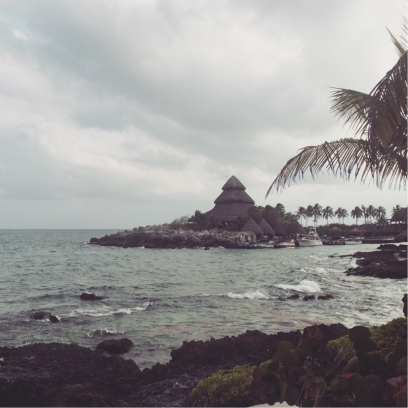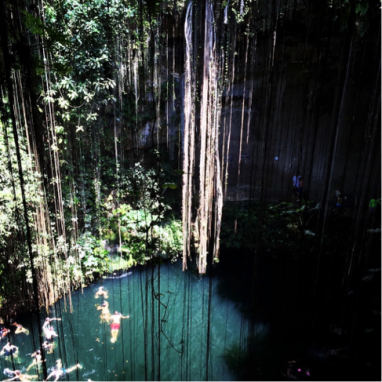Earlier this year I went to Mexico for spring break. During my trip I visited sinkholes (called cenotes) and Xcaret, an eco-archeological park. Xcaret is a combination of an ecological park (open spaces for plants and animals that have built in modifications for human activities) and a cultural park (areas where visitors can observe traditional Mexican culture). We signed up to swim in a cenote, swim in an underground river, snorkel, and go on a river tour. On the bottom of all the receipts from the park there was a blurb which stated that only biodegradable sunscreen and bug repellant are permitted at certain sites and that the request is driven by the organization’s desire to preserve the park’s ecosystems.

The requests for only biodegradable materials made me more conscious of the ways my fellow travelers used sunscreens, bug repellants, and other personal care products. The park offered lots of opportunities to comply with their requests. When we arrived at each location I noticed stations that sold biodegradable sunscreen and bug spray. There were also rinsing stations where people were required to rinse off before entering the sinkholes and rivers.

Unfortunately, in spite of the effort to accommodate people’s needs for sunscreen and bug spray, the park’s efforts were in vain. Very few people purchased the biodegradable products and most continued to apply the non-biodegradable stuff they had brought with them. Also most people (myself included, feeling guilty and ashamed) tried to minimize the amount of time spent in the shower because the water was freezing. Since most people spent fewer than two minutes in the shower, they did not have time to wash thoroughly with soap, and since most bug sprays, sunscreen, and make-up are water proof, our brief rinsing off would have had no major effect in removing these products.
I think people were less motivated to follow some of the rules because they did not fully understand the motivation behind them, or the effect of human presence at the sites. Visitors might know that normally eco systems are resilient and can accommodate minor disturbances,1 and they might think of themselves as minor disturbances that can be tolerated. However, they forget that there are actually thousands of people who visit those sites each day. When each person leaves behind their own trail of personal care products, that can build up over time and overwhelm the ecosystem. Unfortunately the effects of this buildup can be devastating. (For more details on how substances may accumulate in the environment and within plants and animals, I recommend this blog post about bioaccumulation/magnification.)

As mentioned above, one of Xcaret’s goals is to restore some of the wildlife native to the area. There are placards at each station that provide information about the plants and animals in the exhibit as well as Xcaret’s role and method for caring for their natural habitat. One example of a restoration project in the park is that they have recently tried to reestablish the orchid population there. This requires carefully controlled green houses and careful monitoring of the plants’ progress.2 However, putting these plants back into the environment requires very specific conditions and they have successfully reintroduced them at Xcaret.
In the past few years the park has also reintroduced hundreds of thousands of sea turtles to the wild.3 Sadly despite their efforts the turtles’ survival rates are decreased by the non-bio degradable products that still end up in the water and contaminate the plants these turtles eat. The toxic effects of these products destroy the coral reefs and the survival of other animals in the water. This is just one way that the effects of the materials extend beyond the water itself.4,5

Two things I am reminded of when I visit parks, whether it is an eco park like Xcaret or a national park in the U.S., is that people appreciate the beauty of nature and most certainly want to preserve these wonderful spaces for future generations to enjoy. Although the parks in Mexico have largely different species of plants and animals from those in the United States or anywhere else in the world, all of these spaces need to be treated well and allowed to thrive naturally. For this reason there are rules that allow us to preserve the organisms that live in those spaces. Learning more about the conservation work at Xcaret and the effects of non-biodegradable sunscreen and bug spray made me even more committed to following those rules the next time I am at a park, and I hope that reading this blog post can help others come to the same decision.
In A Sand County Almanac Aldo Leopold said, “Our ability to perceive quality in nature begins, as in art, with the pretty. It expands through successive stages of the beautiful to values as yet uncaptured by language.”6 I hope that our appreciation for the beauty and diversity in nature will motivate us to follow park rules and make us more mindful of the impact of our actions.

EDUCATIONAL RESOURCES
- National Oceanic & Atmospheric Administration: Ocean Pollution (multiple activities & resources)
- National Park Service: Scrubbing Water Clean! (specific to the Chattahoochee River area, but can be easily adapted)
REFERENCES
- Holling C. Resilience and stability of ecological systems. Annual Review of Ecology & Systematics. 1973. 4: 1–23. http://www.jstor.org/stable/2096802
- Swarts, N. & Dixon, K.Terrestrial orchid conservation in the age of extinction. Annals of Botany, 2009, 104(3), 543–556. doi: 10.1093/aob/mcp025
- Experiencias Xcaret. Corporate Social Responsibility Report 2015.
- Downs, C. et al. Toxicopathological Effects of the Sunscreen UV Filter, Oxybenzone (Benzophenone-3), on Coral Planulae and Cultured Primary Cells and Its Environmental Contamination in Hawaii and the U.S. Virgin Islands. Archives of Environmental Contamination & Toxicology. 2016, 70: 265-288. doi: 10.1007/s00244-015-0227-7
- Welch, C. Do Sunscreens’ Tiny Particles Harm Ocean Life in Big Ways? National Geographic, 2015.
- Aldo Leopold, A Sand County Almanac and Sketches Here and There. 1949, New York: Oxford University Press.
